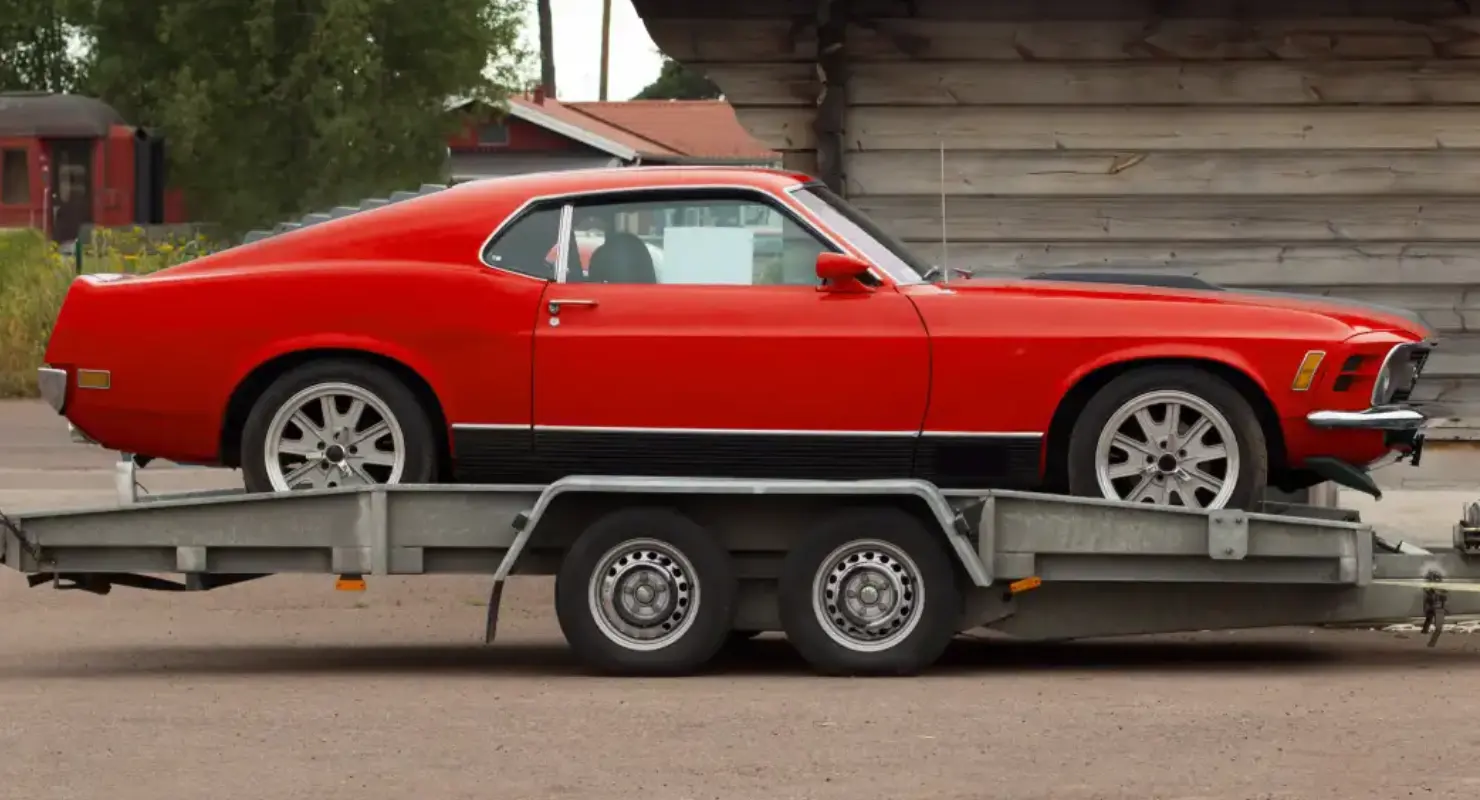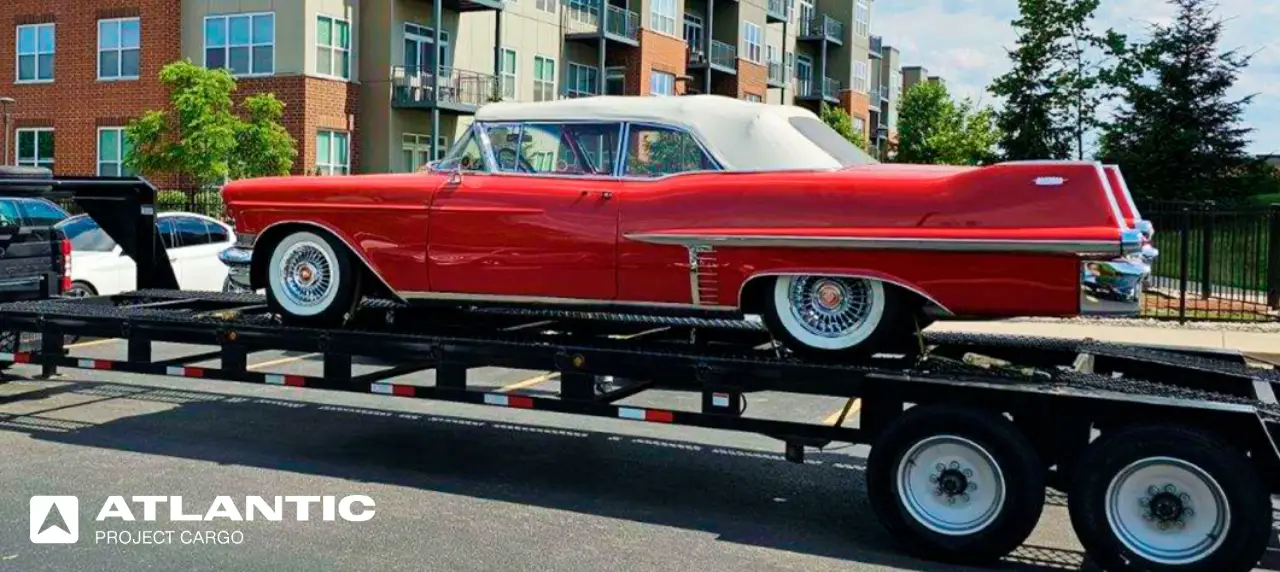
Key Takeaways
- Classic cars older than 25 years are exempt from DOT safety standards, and cars older than 21 years are exempt from EPA emissions regulations
- Rare and historically significant cars can be imported under the Show & Display rule
- Documentation required for old cars import includes a bill of lading, foreign registration, sales invoice, customs entry form, and proof of ownership
- RoRo, container shipping, and air freight are used for importing cars to the USA
Owning a foreign classic car is a dream for a lot of people. However, importing a vehicle into the US can be a complex process that demands your time, money, and patience. US vehicle import laws are difficult to understand, and you can get lost in a bunch of regulations. For example, a 25-year-old law importer can help to bring classic and antique cars to the US, but you need to know about it.
Atlantic Project Cargo’s experts know how to import a car into the United States. We offer comprehensive support throughout the shipping journey, providing expertise in customs brokerage, documentation, and compliance with the US car import laws.
Calculate Import Duty in Minutes!
25-Year Import Law

Many classic and antique cars can be imported into the United States without the need to meet strict emissions and safety regulations, because of the US car import law for 25-year-old vehicles, established under the Imported Vehicle Safety Compliance Act of 1988 (IVSCA).
Under this rule, foreign vehicles at least 25 years old are exempt from Department of Transportation (DOT) safety standards. Additionally, if a vehicle is at least 21 years old, it is also exempt from Environmental Protection Agency (EPA) emissions requirements.
How to Determine If Your Car Qualifies
The 25-year period starts from the manufacturing date, which is usually found on a label inside the car. If the label is missing, you can use other documents, such as:
- An invoice showing the date of the car’s first sale
- A registration document proving the vehicle was registered at least 25 years ago
- A statement from a recognized vehicle historical society verifying the car’s age
What If My Car is Older Than 21 Years but Younger Than 25?
If your car is between 21 and 25 years old, it is exempt from DOT regulations but must still meet EPA safety standards. If the vehicle does not conform to US safety standards, you will need to import it through an Independent Commercial Importer (ICI).
ICIs are the companies that have received authorization from the EPA to legally import cars into the country. The ICI is allowed to perform necessary modifications to bring the vehicles into conformance, making classic auto imports possible.
Do not try to bypass the 25-Year Import Rule
While it is technically possible to import an automobile to the USA before it turns 25 years old under the “display” exemption, this option is extremely limited and not practical.
Attempting to bypass the rule can have serious consequences. Law enforcement may deny your vehicle entry, seize it, or even destroy it on the spot. You could also face huge fines and legal penalties.
Even if you manage to import a vehicle that is not yet 25 years old, selling it later will be nearly impossible. If you find a buyer, expect to receive far less than the car’s actual value. In short, the risks far outweigh the benefits.
Show and Display Rule for Rare Classic Cars

If you are looking to import a rare classic vehicle, the Show & Display Rule might be your best option. This amendment to the Federal Motor Vehicle Safety Standards (FMVSS) allows collectors to bring historically or technologically significant vehicles into the US without following the 25-year rule.
One major limitation is that you cannot use the vehicle for daily driving. A car imported under this rule can only be driven up to 2,500 miles per year.
Eligibility Criteria for the Show & Display Rule
To qualify, a vehicle must meet these requirements:
- Rarity
Typically, only cars with 500 or fewer units produced are eligible - Limited Use
The vehicle cannot be driven more than 2,500 miles annually - Historical or Technological Significance
The vehicle must feature groundbreaking design, engineering, or technology that was considered an advancement at the time of production
Meeting these conditions allows collectors to legally import and showcase rare vehicles without complying with the 25-year import law.
Required Documentation for Importing a Classic Vehicle to the USA
When importing a car that is 25 years old or older, you will need the following documents:
- DOT HS-7 Form
Confirms compliance with US Department of Transportation safety standards or eligibility for an exemption. Complete Box 1, where you must state the vehicle’s age and check the box confirming that it is exempt from DOT safety regulations - EPA Form 3520-1
Required to demonstrate that the vehicle meets the US Environmental Protection Agency emissions standards. Tick the box for category ‘E’ (for exempt) to confirm that the car is over 21 years old - Bill of Lading
Details of the shipment, including shipper, receiver, and vehicle description - Bill of Sale
A detailed document including the purchase price, date of sale, and both buyer and seller information - Customs Entry Form (CBP Form 7501)
Required by US Customs and Border Protection for all imports - Foreign Registration
Proof that the vehicle was previously registered in another country - Proof of Ownership
Certificate of Title or a certified copy of the title
Since customs regulations can change, it is a good idea to consult a licensed car import broker to ensure all paperwork is correct. This can help prevent delays and complications in the process of importing cars from overseas.
Get Your Free Quote Today!
Clean Your Car Before the Shipment
When importing a foreign car into the US, the US Department of Agriculture (USDA) requires a thorough undercarriage cleaning. This helps prevent the introduction of foreign soil, which can carry harmful pests and invasive species.
This can be handled by steam-spraying the vehicle or a thorough cleaning before car transportation.
Shipping Methods for Your Classic Car
Selecting the right shipping method is crucial when importing automobiles into the US. Each option has its benefits depending on your budget, timeline, and the vehicle’s condition.
| Shipping Method | Description | Time | Best for |
|---|---|---|---|
| Roll-on/Roll-off (RoRo) | The vehicle is driven onto the ship’s deck, secured in place, and transported. This is one of the most cost-effective and widely used shipping methods. | 8–10 weeks | Cars are in running condition. |
| Container | The car is placed inside a shipping container, providing additional protection from weather and potential damage. This option is ideal for valuable or delicate vehicles. | 8–10 weeks | Non-running vehicles or those needing extra security. |
| Air Freight | It is the fastest but most expensive shipping method. Often used for luxury, race, or show cars that need to arrive quickly and in perfect condition. | Varies (as fast as the flight duration) | High-value vehicles on a tight schedule. |
Note: No matter which method you choose, always obtain comprehensive cargo insurance. This protects against damage during shipment and reimburses the vehicle’s value in case of a total loss.

Importing Vehicles from Different Countries
When importing a classic car to the United States, the process varies depending on the country of origin. Regulations, taxes, and documentation requirements differ for vehicles coming from Europe, Japan, Canada, and Mexico. Understanding these differences can help ensure a smooth importation of autos to the USA.
Importing a Car from Canada to the USA
Importing a vehicle to the USA from Canada presents a relatively simple process due to its regulatory similarities. The process is further streamlined by the fact that many cars built for the Canadian market already meet US safety and emissions standards.
To import a car from Canada to the US, you will need several documents. First, you must get a tag and insurance from the Canadian province or territory where the car is coming from. You will also need a certificate of origin, the vehicle identification number (VIN), and the Canadian bill of sale.
Although vehicles from Canada may qualify for duty exemptions under the United States-Mexico-Canada Agreement (USMCA), cars produced before 2020 are not likely eligible for duty-free status under this agreement.
Importing a Car from Mexico to the USA
If you plan to import a car to the United States from Mexico, the process is also simple. Many classic cars in Mexico are American-made models that have been maintained or restored locally.
Mexico, like Canada, is part of the USMCA, and cars manufactured before 2020 typically do not qualify for duty-free status under this agreement.
Importing European Cars to the USA
Importing a classic car from Europe is a popular choice, as the continent is home to many prestigious automakers like Porsche or Alfa-Romeo. However, if you are importing European collector cars from countries like Germany or Italy, you will still need to complete the necessary paperwork and comply with the United States vehicle import regulations.
Importing a Vehicle from Japan to the USA
Japan has gained a reputation for producing collectible classic cars, with brands like Toyota, Nissan, and Honda leading the way.
Japan’s car import cost is high because this country is too far away from the United States. Also, Japanese models have right-hand drive configurations, which are legal in the US but may require modifications.
Challenges and Tips for a Smooth Automobile Importation
Importing a classic car into the US comes with its fair share of obstacles. However, with the right preparation, you can navigate these challenges and ensure a hassle-free experience.
Meeting Import Regulations
Understanding and complying with the US car import regulations, including the 25-Year Rule and Show & Display Rule, can be complex. Research the laws beforehand and consult an Independent Commercial Importer or customs broker at Atlantic Project Cargo to ensure your vehicle meets all requirements.
Obtaining Proper Documentation
Missing or incomplete paperwork can lead to delays or even rejection at customs. Gather all required documents in advance. Our car import broker will also help you with this.
Choosing the Right Shipping Method
Selecting an unsuitable shipping method can increase costs or risk damage to the vehicle. Consider RoRo shipping for a running car, container shipping for added security, or air freight for high-value or time-sensitive deliveries.
Unexpected Costs and Fees
Importing a car involves duties, taxes, and fees that can add up quickly. Budget for import duties (2.5% for standard cars), port fees, customs clearance costs, and potential modifications if needed for compliance.
Delays in Customs Clearance
Processing at customs can take longer than expected due to inspections or incomplete paperwork. Work with an experienced customs broker and double-check all documentation to avoid unnecessary delays.
Conclusion
Importing cars, new, classic, or antique, into the USA may be challenging, but for enthusiasts, it can be a rewarding experience. To ensure a smooth process, it is essential to understand key factors like the US auto import laws, select the right shipping method, and work with a reliable vehicle import broker from Atlantic Project Cargo.
The total price to import a car depends on its value, shipping method, import duties, and modifications for compliance. Import duty is typically 2.5% for passenger cars
Import duty for most passenger cars is 2.5% of the vehicle’s value. Some trade agreements, such as the USMCA for Canadian and Mexican cars, may reduce or eliminate these duties.
Yes, but they must meet the United States car import laws. If the car is at least 25 years old, it is exempt from DOT and EPA requirements under the 25-year import law.
Importing a Canadian car to the US requires compliance with DOT and EPA regulations unless the car qualifies for the 25-year rule. You’ll also need to collect the necessary documents, and our vehicle customs broker will help you. Additionally, import duties may apply unless the vehicle qualifies for exemption under USMCA.
Read More



